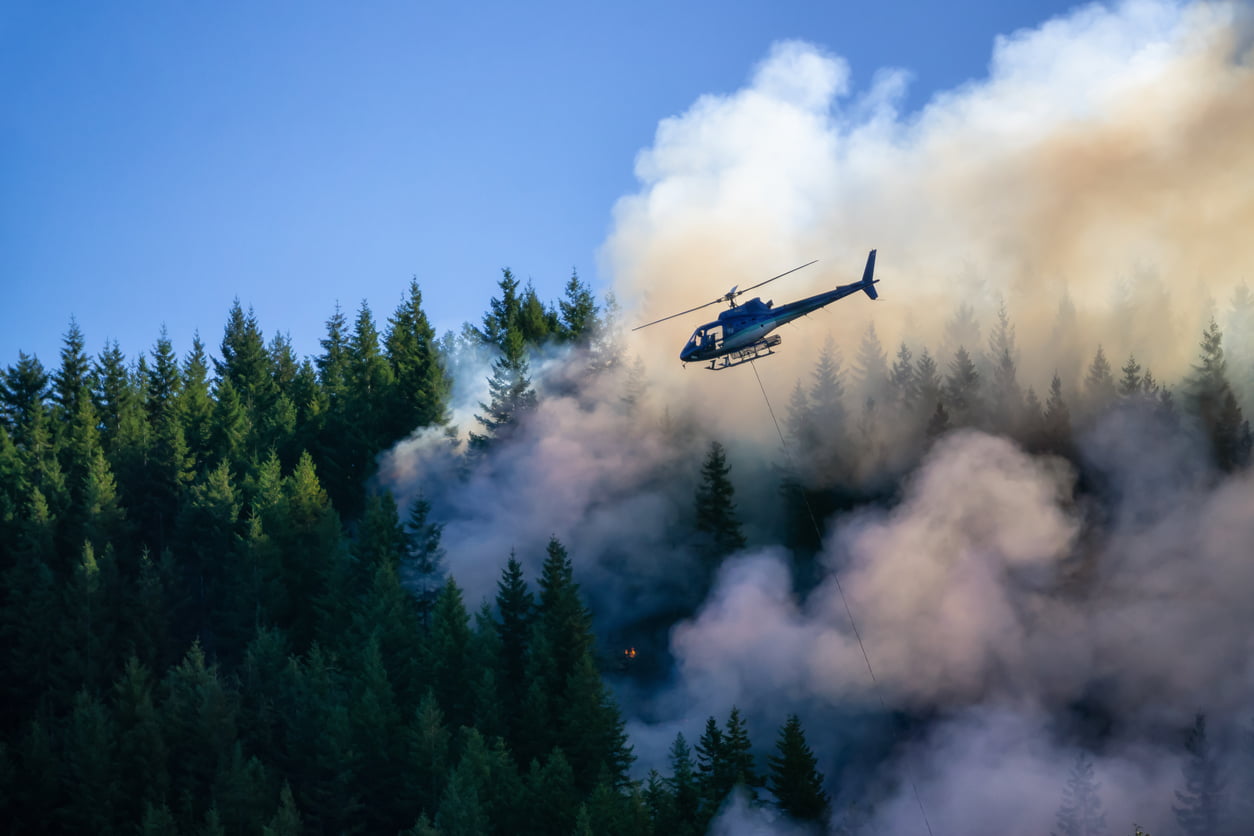Canada is experiencing its most destructive wildfire season on record, as hundreds of blazes burning from coast to coast continue to send plumes of smoke into the atmosphere. Raging wildfires and smoky skies across much of Canada have put a damper on travel this summer, resulting in cancelled plans and closed businesses. Canada’s Emergency Preparedness Minister warned on Monday that 2023 is now on track to be the worst year on record for fires. Are you protected against wildfires in Canada? Will your insurance policies cover your home and any travel disruptions? Let’s examine how the right home and travel coverage can protect you against wildfires.
Fires burning in Ontario
Wildfire season typically happens around this time of year. Canada is home to about 9% of the world’s forests. But with the season occurring annually from May until October, devastation seen from the outset this year put the country on track for its worst season in more than 30 years. The Canadian Interagency Forest Fire Centre says that as of June 29th, there were 428 fires actively burning across the country. 231 of these were out of control. Some 43,000 square kilometres has burned so far this year. There have been 276 forest fires across northern Ontario alone that burned 110,000 hectares. “So after a relatively slow start to the fire season in Ontario, the past few weeks are seeing a significant number of new starts,” says Isabelle Chenard, a Fire Information Officer for the northeast, with the province’s Aviation, Forest Fire and Emergency Services.
Some parts of northern Ontario can have poor air quality due to fires in the region and other provinces. You can track air quality in your area online here.
Wildfire help from across the globe
Hundreds of U.S. firefighters have already arrived in Canada, and more are on their way. About 520 firefighters were battling the blazes with another 150 due to join soon from the army. Reinforcements may arrive in the next few days from New Brunswick, as well as France, the US, Portugal, Spain, and Mexico. Additionally, others around the globe have agreed to assist in the effort, from Australia, New Zealand and South Africa.
Important wildfire statistics
Some important statistics you should be aware of, from CBS.com:
- Over 3,056 wildfires have been reported since the beginning of 2023.
- The fires have scorched at least 8.1 million hectares — or around 20 million acres — of land across Canada this year. That number, since June 29th, has jumped 300,000 hectares, or nearly 750,000 acres, over just 48 hours.
- The acreage burned so far this year recently surpassed the amount of land burned in 1989, which previously held Canada’s annual record. This is according to the country’s National Forestry Database.
- As of June 30th, a slight majority of Canada’s active fires were still classified as “out of control,” with 231 blazes in that category. Of the remaining wildfires, 175 were considered “under control” and another 94 were “being held.” This label is assigned when a fire is not under control, but also is not moving.
4 main consequences of the wildfires in Canada
1. Hot and dry weather in the forecast
The Ontario tourism group released a study last month suggesting leisure travel in the province was set to grow after being hit by the COVID-19 pandemic and cost-of-living crisis. Canada’s travel and tourism industry was set to almost fully recover from the pandemic this year, the World Travel and Tourism Council said in mid-May. With hot and dry weather in the forecast, fire bans remain in effect across most provincial parks in Ontario. “We have had a few conversations with our members and we’re already seeing domestic and international visitors cancelling trips,” says Madison Simmons with the Tourism Industry Association of Ontario. Simmons also says businesses in the northern part of the province, particularly outfitters and outdoor tours, are most affected.
2. Higher cost of living
According to the Insurance Bureau of Canada (IBC), insurers paid out a total of $3.12 billion in insured damages. Each of the last three years saw total payouts exceeding $2 billion. Along with the overall rise in inflation and the ballooning cost of living, higher insurance rates pose a serious threat to affordability. On the insurance side, the IBC is working with the Government of Canada on a National Flood Insurance Program to help homeowners in flood-exposed areas. However, there has been no known similar program underway to help areas prone to wildfires. Meanwhile, rate increases remain inevitable. It’s unclear if there will be some grants coming from the government in future.
3. Cancellations due to air quality
The smoky air has hampered businesses and shut down outdoor recreation programs in many cities in Ontario. Many outdoor events and businesses across Canada have been cancelled or are taking precautions due to poor air quality from wildfire smoke. Canada’s Wonderland says the park is providing KN95 masks to employees who request them. Additionally, breaks and advice on steps to take are available if they or visitors feel unwell. The Toronto Zoo says it is putting precautions in place for animals, including access to the indoors and additional ventilation.
4. Drop in tourism
Smoke from the Canadian wildfires is bringing dirty, hazy air to the northeast United States. In late June, the smoke plume stretched as far as Europe, while air quality alerts went out again for millions of Americans. NASA reports images from its Terra satellite, showing smoke moving across the Atlantic to Europe, affecting Spain and Portugal, and later spreading to other countries. Images from Spain show the sky looking hazy from the smoke. It’s a hazard not only to public health, but also to air travel to and from Canada. And even if you don’t live along the northeast coastline, your flight can be affected. If you have plans to travel, you should anticipate delays if flying to or from New York City, Washington, D.C., Newark, New Jersey, Philadelphia, Charlotte or North Carolina in the near future. This is according to the Federal Aviation Administration.
To learn more about travel insurance coverage, please click here.
Does your home and property insurance cover damage by wildfires?
Damage to your home and contents by fire, including wildfire, is covered by both all-risks property insurance and the basic fire and extended coverage package. It is also covered by most tenant insurance plans. Mass evacuation coverage, which covers temporary living expenses, is also typically included with every property and tenant insurance policy. In Canada, insurance companies work with governing bodies, like the Financial Services Regulatory Authority in Ontario. This is to maintain ongoing communication regarding new threats and insurance rate increases. Unlike in the U.S., especially California, insurance companies are starting to cease selling new insurance policies to property owners in California due to the increase in wildfires.
If you’re travelling to or from the affected areas, or have plans to attend outdoor events–including sporting events, shows, and other activities–you’re bound to be affected in some way. To avoid surprises, make sure you repeatedly check the status of your flights or events. In addition, be sure to speak with one if our isure representatives to ensure you have the right coverage to protect your home or getaway. We can further discuss your policy in regards to wildfire coverage.




